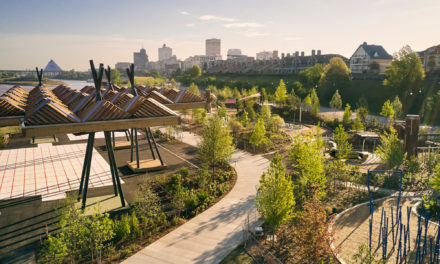If Memphis was a real estate business, we would say that it suffers from a low occupancy rate.
If we ran a shopping center with this problem, we could spend some money making it more attractive and offering special leases, we could lose money and suck it up, or we could raise rents, but if we did, it could lead to our tenants leaving.
The same goes for Memphis. We can spend a lot of money on big-time projects like an NBA arena, Beale Street Landing and Shelby Farms Park in hopes of keeping our taxpayers in the city and attracting more. We can respond to a decrease in people by an increase in revenues in the form of property taxes, but it results in an exodus of families.
A friend of ours offered a lesson for us. Faced with similar scenarios, he made his shopping center smaller. He consolidated the stores that are still successful and ran a smaller, more efficient and more profitable operation.
Tough Times
So, here’s the question: if businesses can downsize, if nonprofit agencies and private institutions can downsize, if the military can downsize, why can’t cities like ours?
We’ve written about Memphis as a shrinking city frequently in the past four years, and to summarize, here’s the premise: we delude ourselves into thinking that annexation is the answer to all that ails us when in fact it simply masks the 28% drop in population in the central city in the past 35 years and we deliver the same services over a larger area and with roughly the same budgets and personnel.
Back behind the annexation in the central city, there’s the same number of water lines, sewers and streets to be repaired and policed, the same number of neighborhoods but even more serious problems to confront. Meanwhile, despite the annexation, more people leave and the downward spiral continues on.
Aggravating the problem is a simple fact of life: the decline across Memphis is not equally distributed. There are census tracts with less than 50% of the population who lived there in 1970. With the expansion of area and concentrated poverty left in its wake, urban life itself deteriorates. There aren’t enough people to keep the grocery store in the neighborhood open, vacant lots become havens for criminal activity, and the neighborhood feels less safe and becomes less livable and inviting.
Misery Loves Company
It’s a self-reenforcing cycle. The problems become more than symptoms of serious challenges. They actually become the source for them.
We have plenty of company. During the 20 years between 1970 and 1990, one third of all U.S. cities lost population. And yet, what is strange about our shrinking city is its location.
Most cities undergoing these changes are Midwestern industrial cities, notably Detroit, St. Louis, and Cleveland. And while Memphis has propped up its population through annexation, like these Midwestern cities, our density has been cut in half.
Cleveland has 3,300 acres of vacant land within its city limits and 12,000-15,000 vacant buildings. That’s why city government there is demolishing up to 2,000 houses a year.
Breaking The Cycle
According to Terry Schwartz, senior planner at the Kent State Cleveland Urban Design Collaborative: “Our goal is to find productive uses for managing, for holding, and for extracting value out of this growing portfolio of vacancy that’s within the city. The rhetoric of shrinking cities is that there is nothing to say that Cleveland or Toledo or Pittsburgh or St. Louis can’t be a good city with a smaller population.
“But the challenge we face is that the vitality, the vibrancy, the density of the city is really scattered, and also in some ways a phrase might be ‘like perforated.’ You have these pockets of strength and growth and what we think of as a convention city, but in between, there are these vast and growing voids where it’s harder and harder to get conventional real estate development to take root.”
Shrinking cities are faced with hard choices. Like Youngstown, they may decide which neighborhood are abandoned because it’s simply too costly to deliver services to them. To accelerate the abandonment already under way, there would need to be incentives to relocate people to neighborhoods that can still be saved.
There’s even discussion of special land-use policies and zero occupancy zoning, which would lead to the elimination of city services. It might sound insensitive, but it’s no less insensitive than the conditions in which our cities in these neighborhoods live now and the pretense of providing public services to neighborhoods which are only glimmers of their former selves.
Bigger May Not Be Better
In Cleveland, they are creating a citywide plan of core investment areas where real estate development and economic development, population growth and stabilization are most likely to occur. Based on market typologies, they are the places of the greatest strength within the city.
We’re not suggesting that Memphis has reached such a crisis point, but we ought to start planning for it. If trends continue and nothing happens to change the trajectory of our region, conditions in these neighborhoods will only get harsher and more untenable, not to mention, unaffordable, and the population of the traditional city will continue to fall.
Some economists suggest that large tracts of land that no longer have to pay city taxes could attract development that would otherwise avoid them like the plague. Perhaps, it could result in decreased costs to the city and increased revenues. Best of all, it might attract people back into the urban area, and perhaps, lured by lower taxes, some of them would be the middle income families we are hemorrhaging.
We know all this runs counter to Americans’ obsession with bigger and bigger as the definition of success. Perhaps, just perhaps, success isn’t measured in larger and larger population. Absent a tax-sharing arrangement or a major overhaul of our tax system, it’s hard to see a way that the population of the “old” city of Memphis will stabilize anytime soon.
Getting The Focus Right
Most of all, we’re not saying that shrinking Memphis would be the magic answer to solving our city’s problems, but it would allow us to target our energy, our efforts and our resources to an area that allows for more efficient deployment of city services.
It’s unlikely that Memphis will ever see a return to the population within the beltway that it once had, but it just may be our best chance of stabilizing things long enough to triage our problems.



